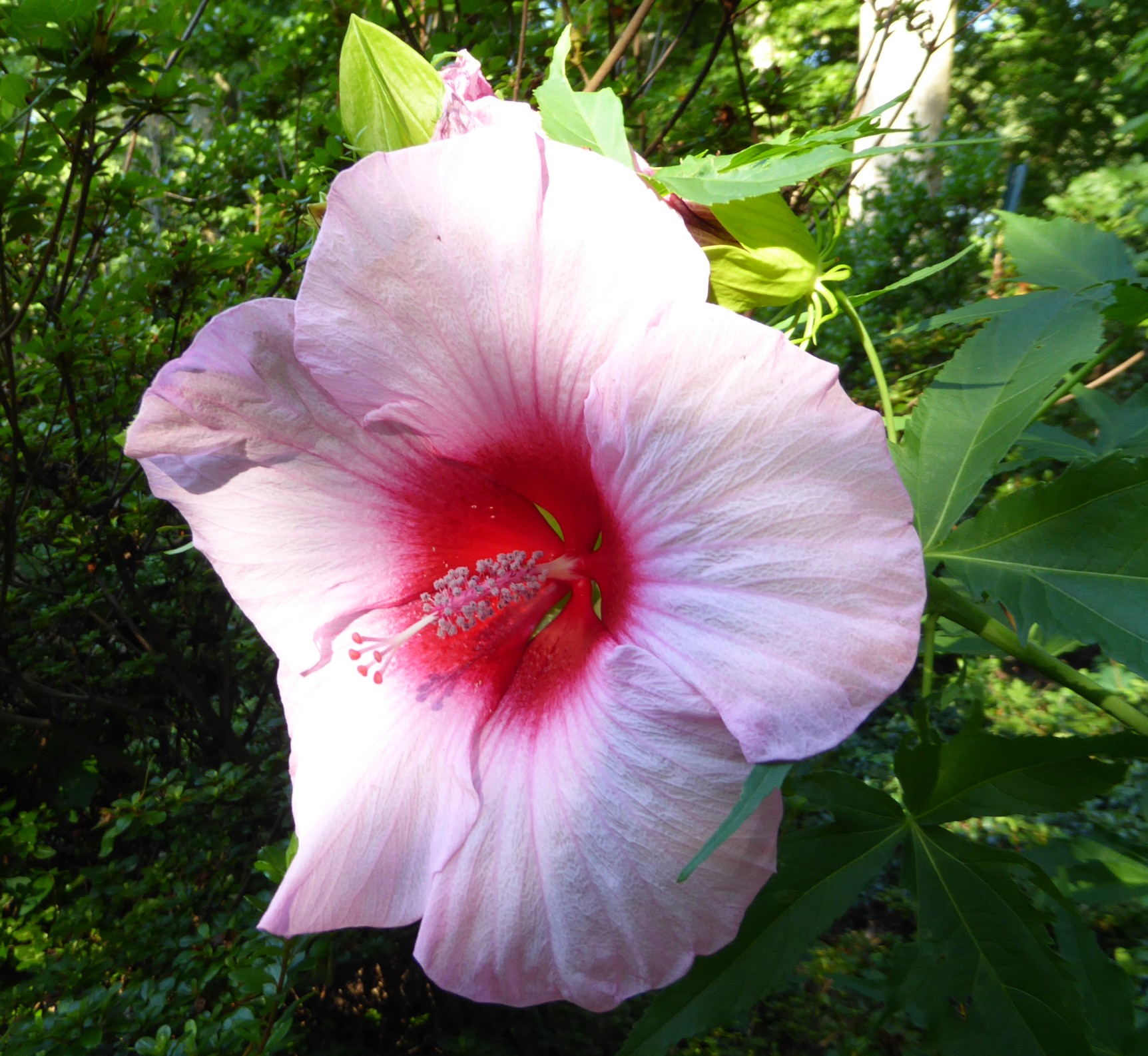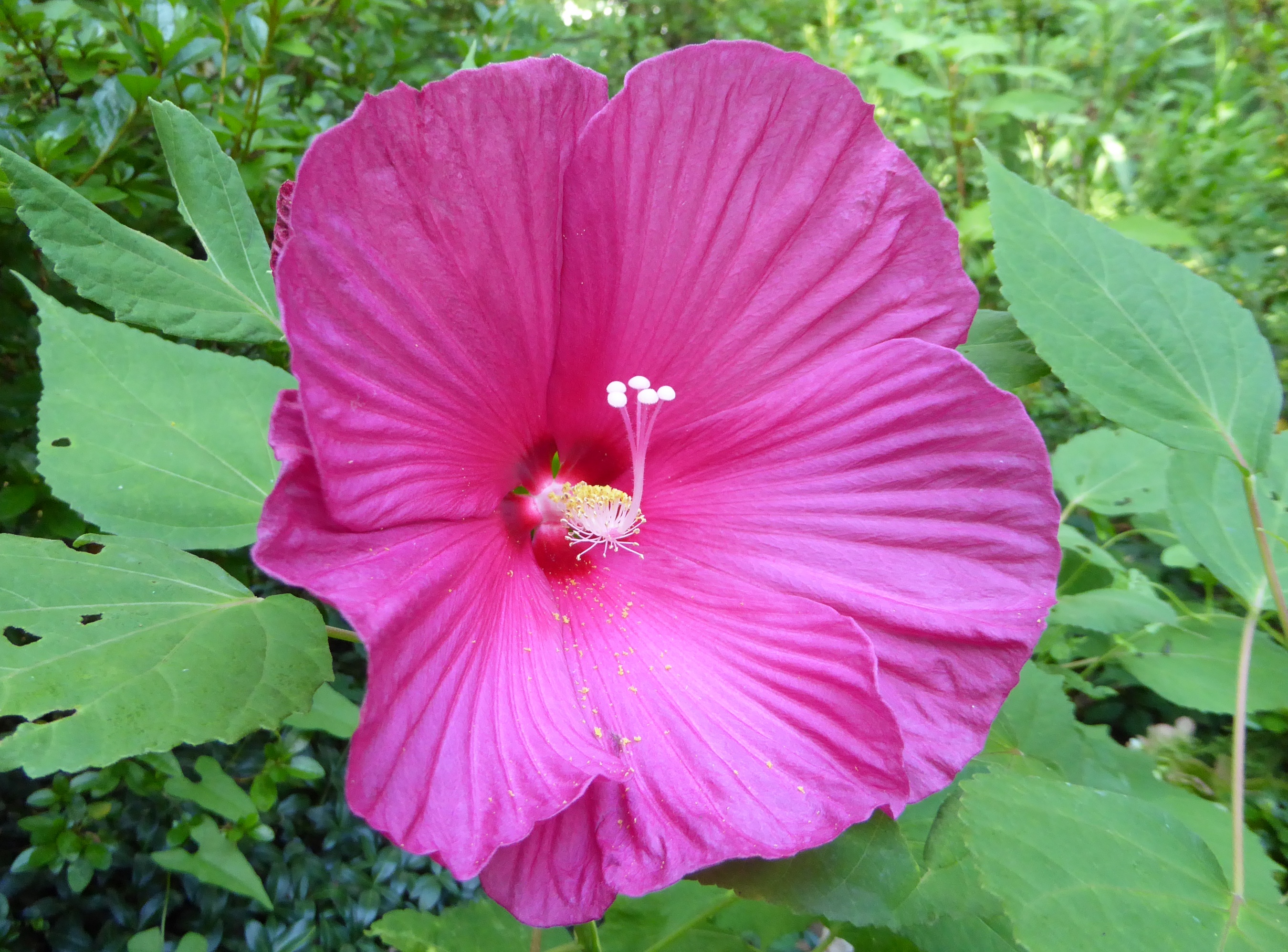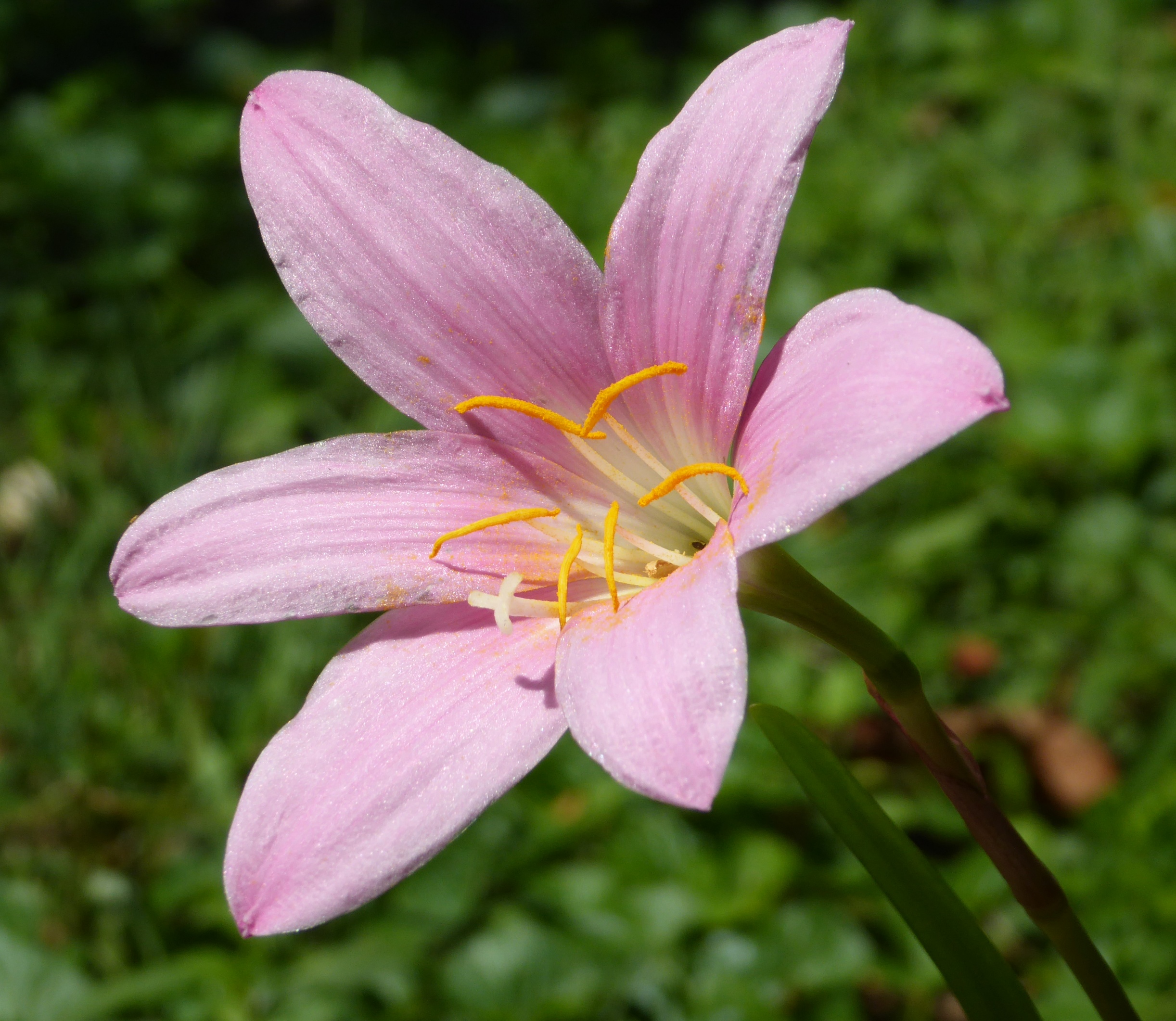Peruvian daffodil
綠鬼蕉 lǜguǐjiāo
spider lily
水鬼蕉 shuǐguǐjiāo
Ismene






Some Peruvian daffodils are in the genus Hymenocallis, some are in Ismene and some are intergeneric hybrids of the two. (Ismene was usually grouped in Hymenocallis until the late 20th century.) Many are also called “spider lilies” despite being unrelated to spiders or lilies.
The Kensington’s Peruvian daffodils are heirloom bulbs that have been in the family for over 50 years. They lack the long, narrow, curved petals typical of Hymenocallides (hymenocallusses?) and hybrids, so appear to be true Ismene. Based on photo comparison, Ismene hawkesii is a close match. The web pages of the Pacific Bulb Society call I. hawkesii “one of the few species of this genus in cultivation”.
As they are not always hardy in Zone 6b/7a Kensington Gardens, they are lifted and overwintered indoors.
Ismene (Ἰσμήνη) was the daughter and half-sister of Oedipus; the genus was named by Richard Anthony Salisbury for unknown reasons, but her complicated genetic lineage seems to match that of Hymenocallis, Ismene and other Amaryllidaceae (as seen by Meerow, et al.).
綠鬼蕉屬是指(Ismene) 通常可會被誤認成水鬼蕉屬(Hymenocallis) ,這個品種是綠鬼蕉。
Endless summer hydrangea
無盡夏繡球花 wújìnxià xiùqiúhuā
八仙花 bāxiān huā 、紫陽花 zǐyáng huā 、洋繡球 yáng xiùqiú
Hydrangea macrophylla ‘Bailmer’


In the background are astilbes and an heirloom hydrangea.
Oakleaf hydrangea
櫟葉繡球花 lìyè xiùqiúhuā
柏葉紫陽花 bǎiyè zǐyánghuā kashiwaba ajisai (日)
Hydrangea quercifolia



Back in late spring, the oakleaf hydrangea sepals were all white. Unlike bigleaf hydrangea (Hydrangea macrophylla), flower color does not vary with soil pH, but with the arrival of summer, the sepals of the infertile outer flowers begin to take on pink stains as they age. By early summer, the fertile inner flowers are in bloom.
Later in the summer:



Rose balsam
鳳仙花 fèngxiānhuā
touch-me-not
봉선화 bongseonhwa (韓)
Impatiens balsamina





Impatiens balsamina is one of the more than 1,000 species of Impatiens. Unlike the popular garden impatiens derived from busy lizzie (I. walleriana) and New Guinea impatiens (I. hawkeri), the rose balsam is rarely found as a nursery plant, but seeds are widely available. Rose balsams readily self-seed and a population can be sustained with sufficient sun.
It has been widely introduced outside of its native range and has important cultural value in East Asia. The Okinawan folk song “Tinsagu nu Hana” (てぃんさぐぬ花; 天咲ぬ花) is named for the flower.
Probably native to India and Burma, the rose balsam is a true annual, with weak, semi-succulent stems. Like other impatiens, seeds are spread by explosive dehiscence of the seed capsules. The mature capsules burst, sending seeds up to several feet away.
In Korea, the flowers were traditionally used to create a fingernail dye. The petals were mashed with cooked with rice and salt; the resulting paste was applied to fingernails and kept in place with a soft leaf wrapping. The 1956 Kim Ki-young (김기영; 金綺泳) movie Touch-Me-Not takes its name from the flower.
봉선화(鳳仙花)원산지는 인도 반도 및 인도 차이나 반도이다。 한국에서는 고려 시대부터 있었다。 옛부터 이 꽃의 분홍색과 빨간색과 자홍색과 보라색의 꽃잎들은 손톱에 물을 들이기 위해 사용되어왔다。 꽃잎들과 밥과 소금 또는 백반을 함께 으깨서 손톱에 바른 후 부드러운 잎으로 싸서 하루 동안 두면 손톱에 물이 든다。 여성들이 언제부터 봉선화로 손톱에 물들였는지 확실하지는 않으나 전설에 따르면 고려 시대 충선왕(忠宣王) 시기의 한 궁녀에 의해 그것이 시작되었다는 전설이 있다。

봉선화로 손톱을 물들이는 행위에 관한 여러가지 속설들이 있다。 빨간색은 귀신을 내쫓기 위해 사용되어서 봉선화로 물들이는 것은 병을 예방한다고 사람들이 믿게 되었다。 또한 봉선화 잎의 색이 첫 눈이 내릴 때까지 유지되면 첫 사랑에 성공한다는 말도 있다。 1956년 김기영(金綺泳) 감독의 영화인 〈봉선화〉도 그 꽃의 이름에서 나왔다。 더 최근에는 하지원과 연정훈 주연의 영화〈키다리 아저씨〉(2005)에서 봉선화로 손톱을 물들이는 장면이 나온다。 2006년 〈백만장자의 첫사랑〉이라는 드라마에서는 현빈과 이연희가 맡은 극중 인물이 사랑을 찾기 위해 손톱에 물을 들인다。
More rose balsams:



Thread-leaved tickseed
輪葉金雞菊 lúnyè jīnjījú
whorled coreopsis, pot-of-gold
Coreopsis verticillata ‘Zagreb’


Lamb’s ears
綿毛水蘇 miánmáo shuǐsū
woolly hedgenettle
Anemone hepatica; Synonym: Stachys lanata





Lamb’s ears are obviously primarily grown for their foliage, but the spike inflorescences that resemble other those of other Lamiaceae (唇形科) are interesting enough when viewed close up. Bumblebees (Bombus sp.; 熊蜂) love the flowers. Bumblebees are identifiable vis-à-vis carpenter bees (Xylocopa sp.; 木蜂) by their hairy abdomens, and in this case, by a prominent golden-yellow pollen basket (corbicula); solitary carpenter bees don’t have pollen baskets. This specimen appears to be one of the area’s bumblebees with a spot on the back of the thorax, e.g. the half-black bumblebee (B. vagans), the two-spotted bumblebee (B. bimaculatus) or the brown-belted bumblebee (B. griseocollis).
Pink rain lily
韭蘭 jiǔlán
風雨蘭 fēngyǔlán、玉簾 yùlián
Zephyranthes


This rain lily is probably a Zephyranthes carinata. Or is it a Zephyranthes minuta (often referred to as Zephyranthes grandiflora)? Leave a comment with your opinion. For more on rain lilies, see the rain lily post. In the background of the left-hand picture is naturalized stand of curly-leaved purple shiso (紫蘇).
Orange skipper coneflower
松果菊 sōngguǒ jú
紫錐菊 zǐzhuī jú
Echinacea ‘Orange273’


In the background are calla lilies (Zantedeschia; 海芋) and thread-leaved tickseeds (Coreopsis verticillata ‘Zagreb’; 輪葉金雞菊). The larger strap leaves behind those of the calla lilies are of Peruvian daffodils (Hymenocallis × festalis; 水鬼蕉).
Bigleaf hydrangea
繡球花 xiùqiúhuā
siù-kiû-hoe (台)
lacecap hydrangea, mophead hydrangea
八仙花 bāxiān huā 、紫陽花 zǐyáng huā 、洋繡球 yáng xiùqiú
Hydrangea macrophylla




All of these photos are of clones of the same heirloom hydrangea taken on the same day. Light and soil influence the time and color of blooms. The two pictures on the left are of a literal late bloomer, on its way to its normal steel blue color. The two on right are of one shrub with shades of pink through lavender to a light purple that is almost blue, with two colors sometimes appearing on the same bloom.
Gayfeather
麒麟菊 qílín jú
dense blazing star
繡線菊 xiùxiàn jú
Liatris spicata







Gardens are always in need of more gaiety and the gayfeather does not disappoint. The long purple spikes are often used in cut flower arrangements and are distinctive because the flowers bloom first from the top of the spike down rather than from the bottom up as is typical of such inflorescences. The photos here show them in various stages of bloom. In the background are orange skipper coneflower (Echinacea; 松果菊) and calla lilies (Zantedeschia; 海芋). The larger strap leaves behind those of the calla lilies are of Peruvian daffodils (Hymenocallis × festalis; 水鬼蕉).
Crocosmia
香鳶尾 xiāng yuānwěi
montbretia, copper tips
Crocosmia × ‘Lucifer’




“Crocosmia” is the name usually used in the U.S. for Crocosmia cultivars, but “copper tips” shows up on trade labeling sometimes. In Britain and Ireland, “montbretia” is used for the orange-flowered crocosmias that are rampantly invasive from Cornwall to Shetland, while “crocosmia” is applied to less aggressive varieties bought for the garden.
Hardy hibiscus
芙蓉葵 fúróng kuí
swamp rose mallow
Hibiscus moscheutos








All of these varieties of hardy hibiscus pictured here propagate easily from seeds collected from dried pods and occasionally self seed.
Hosta
玉簪 yùzān
plantain lily
Hosta


Hostas are prized for their foliage, but these simple hostas can be appreciated for their blooms as well. They have seeded prolifically at Kensington Gardens, naturalizing over a large area, but the efforts of the long-horned giant rats have lately kept them in check.
Kopper king hardy hibiscus
芙蓉葵 fúróng kuí
swamp rose mallow
Hibiscus ‘Kopper King’



The kopper king hibiscus is a hybrid of Hibiscus moscheutos (hardy hibiscus; 芙蓉葵), Hibiscus coccineus (Texas star; 紅秋葵) and Hibiscus laevis (halberd-leaf rosemallow; 戟葉芙蓉, 甲胄木槿) through the female parent and Hibiscus moscheutos through the male parent.
Astilbe
落新婦 luò xīnfù
false goat’s beard, false spirea
Astilbe; Astilbe × arendsii




Behind the astilbes are hardy begonias (Begonia grandis; 秋海棠) and a hydrangea (Hydrangea macrophylla; 繡球花) with a Japanese spurge (Pachysandra terminalis; 頂花板凳果) as a ground cover.
Ice cream astilbe
落新婦 luò xīnfù
false goat’s beard, false spirea
Astilbe ‘Ice Cream’; Astilbe × arendsii ‘Ice Cream’



Pink fizz foamy bells
裂礬根 liè fángēn
Carnival plum crazy alumroot
礬根 fángēn
coral bells
× Heucherella ‘Pink Fizz’ (L 左)
Heuchera × villosa ‘Carnival Plum Crazy’ (R 右)


The racemes of tiny flowers are not sold as the primary attraction of alumroots and foamy bells, but with these two cultivar, the colors make a nice contrast in early summer with the plants’ colorful foliage. Foamy bells (裂礬根) are an intergeneric hybrid of Heuchera (礬根属) and Tiarella (黄水枝属), as reflected in the portmanteaux × Heucherella and foamy bells from the common names “foamflower” and “coral bells”.
Red rocket crape myrtle
紅火箭紫薇 hóng huǒjiàn zǐwēi
Lagerstroemia indica ‘Whit IV’

The red rocket cultivar was developed by Carl Whitcomb, who has patented a dozen other varieties including the dynamite, the standard-setting red crape myrtle. The red rocket is faster growing and has larger flower clusters than the dynamite. The blooms hold their color even in less-than-ideal conditions.
Fishwort
魚腥草 yúxīngcǎo
chameleon plant, fish mint, orange peel plant, lizard tail
臭臊草 chhàu-chho-chháu (台)、狗貼耳 káu-tah-hīⁿ (台)、手藥 chhiú-io̍h (台)、魚臭草 hî-chhàu-chháu (台)
giấp cá, คาวตอง
Houttuynia cordata






The lighter shades of green on the fishwort leaves in the photos here gradually fade and change to white, pinks and reds as the summer wears on. Synonyms for the variegated H. cordata ‘Chameleon’ cultivar, including H. cordata ‘Court Jester’, H. cordata ‘Flame’, H. cordata ‘Tricolour’ and H. cordata ‘Variegata’, reflect these colors.
Fishwort is highly invasive although the variegated version is supposedly a little less aggressive. It cannot be removed by digging it up as its rhizomes grow deep and are highly brittle; plants can regrow from these broken root bits or from stem segments. Persistent use of herbicides seems to be the only option for control or removal.
Fishwort is characterized by a strong fish-like smell from houttuynine, its volatile oil. Despite (or because of?) this smell, the plant has a variety of culinary and medicinal uses in East Asia, Indochina and Northeast India. It is drunk as a medicinal tisane (魚腥草茶; 蕺草茶/どくだみ茶; 어성초차) in east Asia and is a dietary supplement (viên giấp cá) or powder (bột diếp cá/𥹸葉𩵜) in Vietnam. The fresh leaves (raw and cooked) and roots are used in the cuisines of Southwest China, Vietnam and Northeast India.
Tiny dino Asiatic lily
亞洲百合 Yǎzhōu bǎihé
Lilium ‘Tiny Dino’
Garden phlox
天藍繡球 tiānlán xiùqiú
Phlox paniculata



This cultivar is probably ‘Blue Flame’.























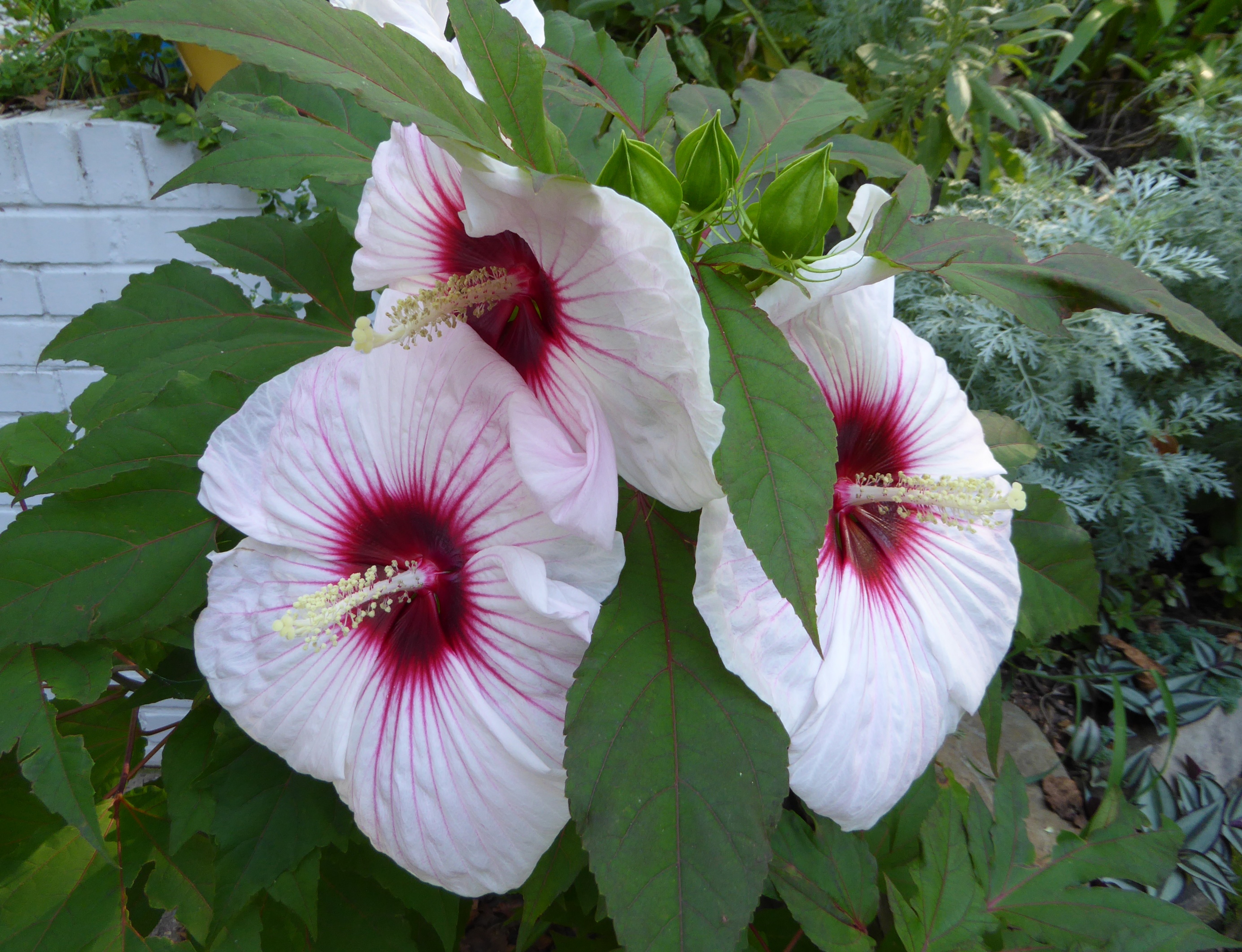
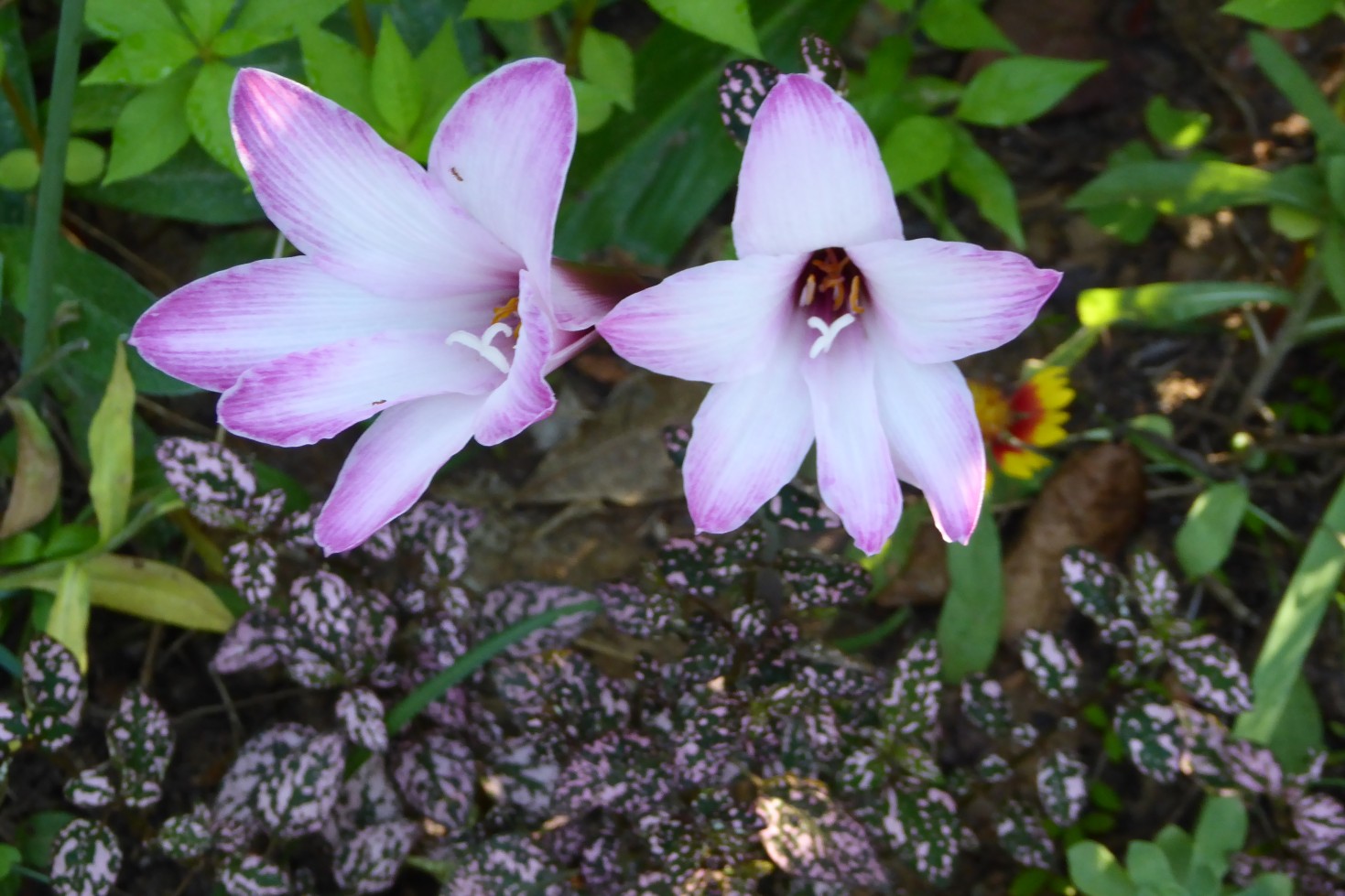 Heirloom rain lilies that have been in the Kensington family for 40 years, propagated by copious offsets. These survive outdoors only in the warmest spots of the 6b/7a hardiness-zone winters of Kensington Gardens. In the background is the tropical subshrub polka dot plant (嫣紅蔓
Heirloom rain lilies that have been in the Kensington family for 40 years, propagated by copious offsets. These survive outdoors only in the warmest spots of the 6b/7a hardiness-zone winters of Kensington Gardens. In the background is the tropical subshrub polka dot plant (嫣紅蔓 